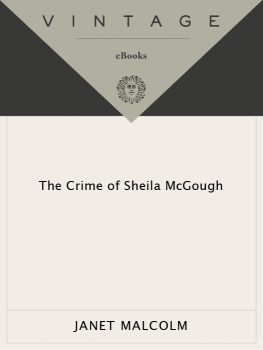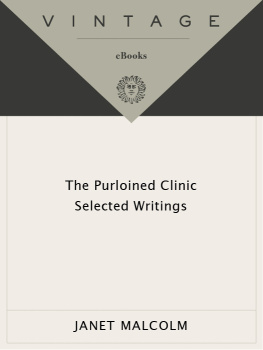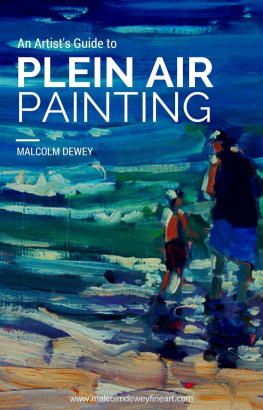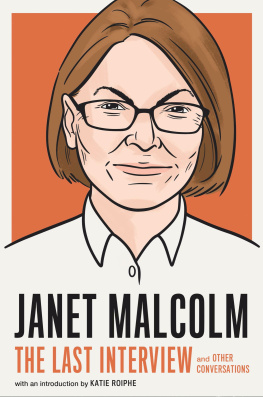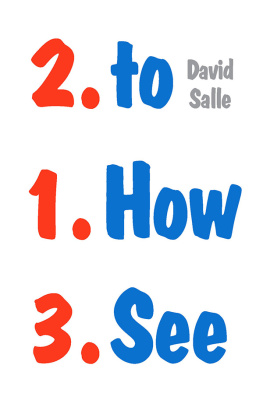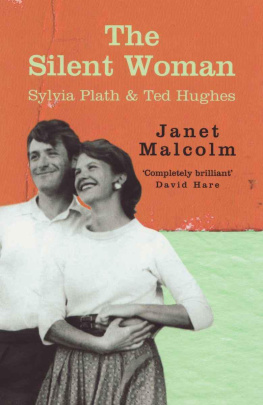
The author and publisher have provided this e-book to you for your personal use only. You may not make this e-book publicly available in any way. Copyright infringement is against the law. If you believe the copy of this e-book you are reading infringes on the authors copyright, please notify the publisher at: us.macmillanusa.com/piracy.
To the memory of Gardner
CONTENTS
INTRODUCTION
by Ian Frazier
Janet Malcolm is a wild writer. A first-time reader of her work might not expect this, given the carefully described domestic scenes where many of her journalistic dramas begin. Early in her career she wrote a column for The New Yorker called About the House, which discussed the beauty of simplicity, among other related subjects, and sharpened her eye for interiors. If you go back today and read those columns in light of her later pieces they somehow seem also to shimmer with a rich and possibly sinister foreshadowing. A lot of journalism is a bedtime story you are sleepily hearing for the hundredth time, but with a piece by Janet Malcolm you never know where things will lead. I have read pieces in which I watch her make a swerve, and I straighten up in my chair and gasp and try to correct her errant and scary course with body English, as if I were sitting at a hotel window watching a car drive calmly up an off-ramp. The chance of being taken completely by surprise keeps you alert through everything she writes. That she is smarter than almost everybody goes without saying; plus, I know of no other nonfiction writer who can be more hair-raisingly fun to read.
Once I interviewed Ms. Malcolm onstage at the New Yorker Festival. The large audience was full of people who knew her work well, as I could tell by the texture of their listening quiet. During the questions period someone asked about the first sentence of her book The Journalist and the Murderer , a work that examines the relationship between Jeffrey MacDonald, a man convicted of a terrible crime, and Joe McGinniss, the writer who befriended MacDonald and wrote a book about him. The sentence is, Every journalist who is not too stupid or too full of himself to notice what is going on knows that what he does is morally indefensible. (And by the way, this is a rare example of a Malcolm piece in which the wild ride starts at the first word.) I had figured a question about the sentence was likely to come up, because it is probably the most widely known sentence she ever wrote, and one of the most discussed in all modern nonfiction. The questioner said he disagreed with it and he asked her to explain it.
Honestly, the sentence had freaked me out, too, when I read it the first time. Back then I had reacted to it with indignation. Later I realized how subtle it was, and that it had a real point. To the questioner at the event Ms. Malcolm replied that the sentence could be taken as a premise, a proposal for debate. What had brought me up short about the statement originally was that it could be proposed at all. I guess I had assumed that as a writer I was exempt from moral scrutiny. But to write is to judge, if only implicitly, and a judge is also getting something out of the transaction, and can be judged himself, and may actually be doing something indefensible. The interesting question that The Journalist and the Murderer posed was whether a writer has any obligation to a subject whose crime puts him outside the world of decent people. Is it okay for a writer to betray someone the writer is writing about, when that someone is a depraved murderer? The interesting conclusion turns out to be that it is not.
Moral questions of such weight set many of Ms. Malcolms plots in motion and get people careening around and crashing into one another and implicate the reader and sometimes the writer, too. Throughout her work she follows, quietly and unassumingly, what she has called the spectre of wrongdoing. The pursuit takes her through domestic and social and cultural arrangements of all kinds, willy-nilly, as if she were one of those outdoor enthusiasts who follow lines of latitude or longitude guided by handheld GPS and regardless of what is in their way.
* * *
This collection, Ms. Malcolms first since The Purloined Clinic: Selected Writings (1992), brings together a wide range of pieces that display her unique skills. To cite just one: she is the best describer of mess and chaos working today. In fact, I cant think of a better one ever. Her patience for confusion and her due deliberation in sorting it out areI dont knowAugustinian? (Im thinking of a section in The Confessions of St. Augustine where he parses the doctrinal errors of the Manicheans.) Ms. Malcolm can descend into mind-numbing chaos and depict its elements severally and collectively and bring order to it as if she were swooping in and out on one of those grand old-time dolly shots in the movies. A good big mess activates her powers to the full. In this book a fine example is her elucidation of the controversy around the installation of Richard Serras sculpture Tilted Arc in the plaza of a federal office building in lower Manhattan some years ago. When she takes on something complicated and messy like that I always want a front-row seat.
Ms. Malcolms quick and precise sketching of interiors and related domestic detailsnote her double and triple takes as she tries to register the art-designed neutral immaculateness of the studio of David Salleis another reliable pleasure of this collection, as is the focus she brings to writing about people who happen to be a bit nuts. Perhaps because her father was a psychiatrist she has a fondness for nuts, and they turn up throughout her work; examples here are her picture of Julia Margaret Cameron, the Victorian-era photographer, and of Gene (Geneva) Stratton-Porter, author of A Girl of the Limberlost , who wrote sweet-natured popular novels extolling material comforts a hundred years ago and who also as a side interest worked out intricate and awful theories of racial purity.
One of Ms. Malcolms recurring themes examines the hazards of portraiture. Being so careful and self-aware and circumspect with her own human subjects, she waxes irate at the large number of writers who arent. Anyone planning to write a biography should first read Janet Malcolm to get an idea of how the process usually goes wrong. When she notes that biographical research leads to a kind of insufferable familiarity, she defines the one-way relationship between the mute, helpless, dead biographee and the all-too-alive biographer. Simply, and sensibly, Ms. Malcolm favors hewing to the subjects own words and surviving documents; as she points out, biography (like its progenitor, history) functions as a kind of processing plant where experience is converted into information the way fresh produce is converted into canned vegetables. But, like canned vegetables, biographical narratives are so far removed from their sourceso altered from the plant with soil clinging to its roots that is a letter or a diary entrythat they carry little conviction.
When I interviewed Ms. Malcolm at the festival she had just published her piece about Thomas Struth, one of the most successful art photographers in the world (Depth of Field). Much of the piece is about Struths photographing Queen Elizabeth and Prince Philip for an exhibition celebrating her sixty years as queen. Everybody loves Struth, and Ms. Malcolms portrait of a portraitist came up against the rather unfamiliar problem (for her) of a subject who is brilliant, widely liked, and completely nice.


